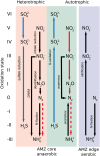Microbial oceanography of anoxic oxygen minimum zones
- PMID: 22967509
- PMCID: PMC3479542
- DOI: 10.1073/pnas.1205009109
Microbial oceanography of anoxic oxygen minimum zones
Abstract
Vast expanses of oxygen-deficient and nitrite-rich water define the major oxygen minimum zones (OMZs) of the global ocean. They support diverse microbial communities that influence the nitrogen economy of the oceans, contributing to major losses of fixed nitrogen as dinitrogen (N(2)) and nitrous oxide (N(2)O) gases. Anaerobic microbial processes, including the two pathways of N(2) production, denitrification and anaerobic ammonium oxidation, are oxygen-sensitive, with some occurring only under strictly anoxic conditions. The detection limit of the usual method (Winkler titrations) for measuring dissolved oxygen in seawater, however, is much too high to distinguish low oxygen conditions from true anoxia. However, new analytical technologies are revealing vanishingly low oxygen concentrations in nitrite-rich OMZs, indicating that these OMZs are essentially anoxic marine zones (AMZs). Autonomous monitoring platforms also reveal previously unrecognized episodic intrusions of oxygen into the AMZ core, which could periodically support aerobic metabolisms in a typically anoxic environment. Although nitrogen cycling is considered to dominate the microbial ecology and biogeochemistry of AMZs, recent environmental genomics and geochemical studies show the presence of other relevant processes, particularly those associated with the sulfur and carbon cycles. AMZs correspond to an intermediate state between two "end points" represented by fully oxic systems and fully sulfidic systems. Modern and ancient AMZs and sulfidic basins are chemically and functionally related. Global change is affecting the magnitude of biogeochemical fluxes and ocean chemical inventories, leading to shifts in AMZ chemistry and biology that are likely to continue well into the future.
Conflict of interest statement
The authors declare no conflict of interest.
Figures





References
-
- Wyrtki K. The oxygen minima in relation to ocean circulation. Deep-Sea Res. 1962;9:11–23.
-
- Kamykowski D, Zentara S-J. Spatio-temporal and process-oriented views of nitrite in the world oceans as recorded in the historical data set. Deep-Sea Res. 1991;38:445–464.
-
- Thamdrup B, Dalsgaard T, Revsbech NP. Widespread functional anoxia in the oxygen minimum zone of the eastern South Pacific. Deep Sea Res Part I Oceanogr Res Pap. 2012;65:36–45.
-
- Cohen Y, Gordon LI. Nitrous oxide in the oxygen minimum of the eastern tropical North Pacific: Evidence for its consumption during denitrification and possible mechanisms for its production. Deep-Sea Res. 1978;25:509–524.
-
- Nicholls JC, Davies CA, Trimmer M. High-resolution profiles and nitrogen isotope tracing reveal a dominant source of nitrous oxide and multiple pathways of nitrogen gas formation in the central Arabian Sea. Limnol Oceanogr. 2007;52:156–168.
Publication types
MeSH terms
Substances
LinkOut - more resources
Full Text Sources

